Sukkur, Pakistan: Freshwater dolphins are flourishing in a stretch of Pakistan’s main river after a helping hand from fishermen mobilized to defend a rare species driven to near-extinction.
Identifiable by their saw-like beaks, Indus River dolphins once swam from the Himalayas to the Arabian sea, but now mostly cluster in a 180-kilometer (110-mile) length of the waterway in southern Sindh province.
A glimpse of a dolphin cutting through muddy water to gasp for air is a regular sight along the mighty river, but most villagers nearby were unaware their neighbors were on the brink of extinction.
“We had to explain that it was a unique species only found in the Indus and nowhere else,” Abdul Jabbar, who gave up fishing for a job on the dolphin rescue team, told AFP on the banks of Dadu Canal, which he patrols by motorbike.
Decades of uncontrolled fishing and habitat loss caused by pollution and man-made dams saw the dolphin population plummet to around 1,200 at the turn of the century.
They are classed as an endangered species by the International Union for Conservation of Nature, which says their numbers have fallen by more than 50 percent since the 1940s.
In a bid to turn around the fortunes of the mammals, Pakistani wildlife officials began a painstaking door-to-door awareness campaign with the local fishing community on the riverbanks and arterial canals.
They offered advice on dolphin-friendly nets and warned against harmful and illegal poison-fishing — the practice of using chemicals to kill small fish used for poultry feed.
The World Wide Fund for Nature also offered up one million rupees ($6,300) worth of loans, encouraging fishermen to set up alternative businesses.
With the help of the provincial wildlife department, they established a dolphin monitoring network of 100 volunteers and a handful of paid staff, and a 24-hour phone helpline for villagers to call if they see a dolphin in distress.
Jabbar’s commitment is now boundless.
He recently missed the birth of his child when a dolphin became trapped in one of the river’s canals.
“The doctors were preparing for the caesarean and I needed to be with my wife. But when the call came, I rushed that night to rescue the dolphin,” he told AFP.
The latest survey, from 2017, showed numbers had rebounded to about 1,800 and wildlife officials expect the population has increased further since.
Local legend has it that the first Indus River dolphin was once a woman, transformed by a curse from a holy man angry that she forgot to feed him one day.
Previous generations believed the dolphins — known locally as bullen — were cursed.
They have evolved to be functionally blind, allowing for a sharpened sense of sonar as they cut through the muddy waters of the river hunting for prey.
Harmful fishing practices are not the only hazards facing dolphins.
Every January, when water levels are at their lowest, the floodgates to canals are shut for cleaning, creating pools and lagoons that become death traps for stranded marine life.
Wildlife Department official Adnan Hamid Khan told AFP that the recent steady rise in dolphins had been a “success story.”
“But with a larger population comes food shortages, decreased range of movement — their breeding ground and territory has shrunk.”
Indus River dolphins first came under threat during British colonial rule when dams were built to control the waterway’s flow, and later from the discharge of hazardous chemicals when factories sprung up along its banks.
Untreated sewage from rapidly expanding cities and towns is also dumped into the water, Khan said.
But with fishermen on their side, there is some hope for the species.
“Now we save the dolphins with as much dedication as we would a human being,” said Ghulam Akbar, another volunteer monitor who also turned to farm fishing in an attempt to limit his impact on the river.
“They breathe like we humans do. Every compassionate man should save them.”
Foe to friend: Fishermen join fight to save endangered Pakistan dolphin
https://arab.news/6zs9b
Foe to friend: Fishermen join fight to save endangered Pakistan dolphin
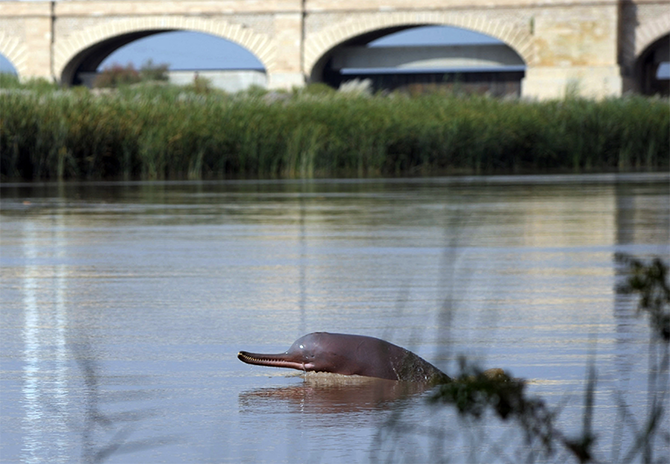
- Decades of uncontrolled fishing and habitat loss caused by pollution and man-made dams saw the dolphin population plummet to around 1,200
- In a bid to turn around mammals' fortunes, local wildlife officials began painstaking door-to-door awareness campaign
Amid investment push, Uzbek foreign minister in Pakistan to discuss trade, regional connectivity
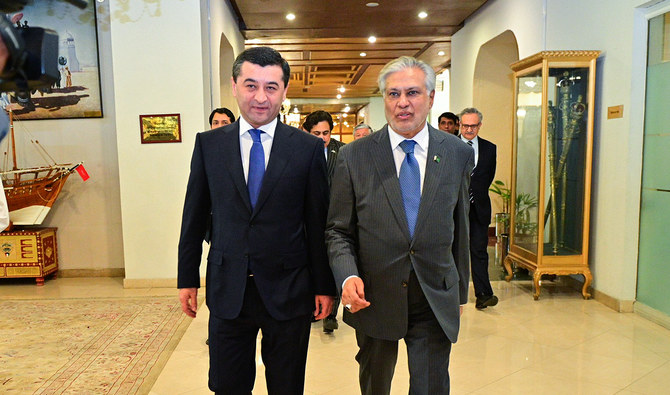
- The government has been hosting official and business delegations to address the economic challenges faced by the country
- Pakistan is interested in reliable Central Asian energy sources and sees Uzbekistan as gateway to other markets in the region
ISLAMABAD: Uzbekistan’s Foreign Minister Bakhtiyor Saidov arrived in Pakistan for a two-day visit on Tuesday night to discuss bilateral trade and regional connectivity, confirmed a brief statement circulated by the foreign office, as the administration in Islamabad is trying to bolster economic ties amid financial challenges.
A Saudi business delegation recently concluded its visit to the country where its members held a series of business-to-business meetings to explore investment opportunities across various sectors during their visit.
This was followed by a meeting between Prime Minister Shehbaz Sharif and Japanese industrialists, where the PM encouraged them to invest in Pakistan’s electric automotive industry. Similarly, Federal Minister for Finance Muhammad Aurangzeb engaged with international investors, assuring them of the country’s commitment to create an enabling business environment. The impending visit of Saudi Crown Prince Mohammed bin Salman, expected this month, is anticipated to bring several billion dollars in investments.
The Uzbek foreign minister’s trip also highlights the strengthening bilateral relations between the two states and aligns with Pakistan’s objectives of enhancing regional connectivity for greater economic prosperity.
“Foreign Minister Saidov will call on Prime Minister Muhammad Shehbaz Sharif and hold in-depth talks with Deputy Prime Minister and Foreign Minister Mohammad Ishaq Dar on a wide range of bilateral issues of mutual interest, with special focus on trade and connectivity,” the foreign office said in a statement released before his arrival.
“The visit of the Foreign Minister of Republic of Uzbekistan is expected to provide fresh impetus to the friendly relations between the two countries,” it added.
Pakistan views Central Asian countries as crucial partners in enhancing regional trade and energy security.
The region’s vast natural resources, especially oil and gas, can be vital for Pakistan to secure reliable energy sources and diversify its energy imports.
Uzbekistan plays a key role in this equation due to its geographical position and resources, acting as a gateway for Pakistan to access other markets in the region.
Last year, Pakistan’s former caretaker prime minister Anwar-ul-Haq Kakar visited the Central Asian country to participate in an Economic Cooperation Organization (ECO) meeting where he reiterated his country’s commitment to regional cooperation and economic integration.
Pakistan invites China to establish industrial zones for electric car manufacturing
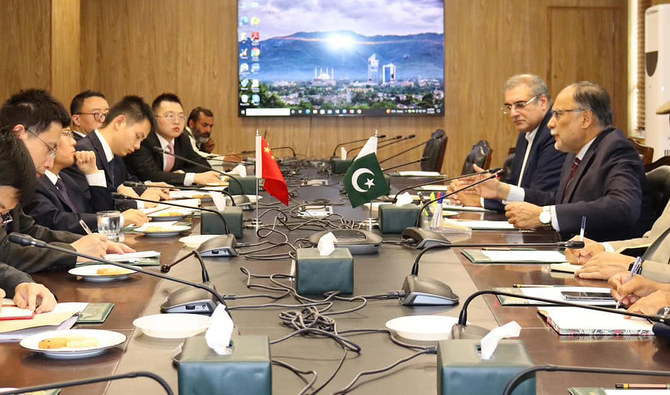
- Earlier this year, Pakistani car maker Sazgar Engineering unveiled electric car made in collaboration with China
- Road transport is significant contributor to pollution as around 23 percent of Pakistan’s greenhouse gases come from vehicles
ISLAMABAD: Pakistan’s planning minister has invited China to collaborate with Islamabad in setting up industrial zones to manufacture electric cars amid a renewed push to attract foreign investment, state news agency APP reported on Wednesday.
The government of Pakistan approved an ambitious National Electric Vehicles Policy (NEVP) in 2019 with the goal of electric vehicles comprising 30 percent of all passenger vehicle and heavy-duty truck sales by 2030, and an even more ambitious target of 90 percent by 2040. For two- and three-wheelers, as well as buses, the policy set a goal of achieving 50 percent of new sales by 2030 and 90 percent by 2040.
In a meeting with Chinese officials on Tuesday, Planning Minister Ahsan Iqbal invited them to collaborate on the production of electric cars.
“He emphasized Pakistan’s aim to establish industrial zones for the manufacturing of electric cars in collaboration with China, leveraging Pakistan’s competitive advantage to reduce overall production costs and create employment opportunities for Pakistani workers,” APP reported.
Earlier this year, Sazgar Engineering, one of Pakistan’s leading car manufacturers, unveiled the electric vehicle “ORA 3,” manufactured in collaboration with Chinese car manufacturer Great Wall Motors (GWM).
The urban areas of Pakistan exhibit some of the world’s highest levels of air pollution, primarily due to sub-2.5 μm particulate emissions. This issue significantly impairs both the country’s economy and the quality of life of its residents. Road transport is a significant contributor to air pollution as around 23 percent of Pakistan’s greenhouse gas emissions originate from vehicles.
On Tuesday, Prime Minister Shehbaz Sharif also met a delegation of Japanese industrialists in Islamabad and invited them to invest in Pakistan’s electric automotive industry.
“There is a wide potential for investment in the electric vehicle industry in Pakistan and Japanese companies with the best technology can take full advantage of it,” Sharif told the Japanese group.
Pakistan court orders Imran Khan’s wife to be moved from house arrest to Adiala Prison

- Bushra Bibi had petitioned court to shift her from Bani Gala home to Adiala Jail where Khan is also imprisoned
- Bushra has been handed two sentences, 14 years in graft case and 7 years for violating Pakistan’s marriage law
ISLAMABAD: The Islamabad High Court (IHC) on Thursday ordered that ex-premier Imran Khan’s wife Bushra Bibi be transferred from her Banigala residence, declared a sub-jail, to Adiala Jail, where her husband is incarcerated.
Bushra has been living under house arrest at her husband’s sprawling Bani Gala mansion in Islamabad since Jan. 31 when both were sentenced to 14 years in prison in a case that relates to accusations they undervalued gifts from a state repository and gained profits from selling them while Khan was prime minister from 2018-22. Khan is jailed at Rawalpindi’s Adiala Jail.
In February, Khan and his wife were also sentenced to seven years on charges they violated the country’s marriage law when they wed in 2018 — the fourth sentence for Khan and the second for his wife.
Bushra had petitioned the court several months ago that she should be moved to Adiala and the IHC had reserved its verdict in the case on May 2.
“Court has annulled notification of house arresting former first lady Bushra Bibi at Bani Gala sub-prison and ordered her transfer to Adiala Prison,” Khan’s Pakistan Tehreek-e-Insaf political party said in a message to reporters.
During Thursday’s hearing when the court reserved its judgment, Bushra’s lawyer Usman Gill said after her sentencing in the state repository case by the trial court, his client went to Adiala Jail as per the trial court order which was also forwarded to the jail superintendent. But on the orders of the interior ministry, the chief commissioner issued an “illegal notification for transfer” to Bani Gala, the lawyer argued.
“There was no instruction from the authorities concerned regarding the transfer from Adiala Jail to Banigala,” he said.
“Neither the provincial government nor did the Punjab prisons inspector general issue any such directive [for transfer] … The place of imprisonment was to be determined by the trial court and not the chief commissioner.”
The state’s counsel argued that Bushra was moved to Bani Gala because of security threats.
“Were the 141 women who were brought to Adiala after Bushra less privileged?” the judge hearing the case asked, saying they too should be imprisoned at their homes then.
“Sometimes you say that [you] cannot present her [Bushra] in the court as there are threats and at times, you say that the jail is not secure. Are you secure?” the judge quipped. “If I am confined in my home by my own will, I would be very happy but how can a prisoner’s property be turned into a sub-jail against his will?”
The IHC subsequently reserved its verdict on the petition.
CASES
In a separate petition to the court filed last month, Bushar, a deeply religious woman widely believed to be Khan’s spiritual guide, alleged she was being poisoned through contaminated food and subjected to “mental and physical torture which is becoming a serious threat to her health and life.” She also alleged that her room and bathroom had been bugged and multiple hidden cameras installed in a “blatant violation of her privacy, dignity and honor.”
The petition said Bushra was only given ten minutes for meetings with family members and lawyers, with five jail staff supervising at all times.
Khan was first jailed after being handed a three-year prison sentence in August 2023 by the Election Commission for not declaring assets earned from selling gifts worth more than 140 million rupees ($501,000) in state possession and received during his premiership. In January, Khan and Bushra were handed 14-year jail terms following a separate investigation by the country’s top anti-graft body into the same charges involving state gifts.
An anti-graft court in Islamabad also handed Khan a 10-year jail term in January for revealing state secrets, a week before national elections on Feb. 8. The ruling on his marriage to Bushra and a seven-year sentence each for both also came ahead of the polls.
Khan has also been indicted under Pakistan’s anti-terrorism law in connection with violence against the military that erupted following his brief arrest related to the Al-Qadir case on May 9. A section of Pakistan’s 1997 anti-terrorism act prescribes the death penalty as maximum punishment. Khan has denied the charges under the anti-terrorism law, saying he was in detention when the violence took place.
Khan’s convictions, which mean he is banned from holding public office, ruled the 71-year-old out of the February general elections. Arguably Pakistan’s most popular politician, Khan says all cases against him are motivated to keep him out of politics.
Taliban reject Pakistan’s claim Afghan bomber involved in deadly attack on Chinese dam engineers
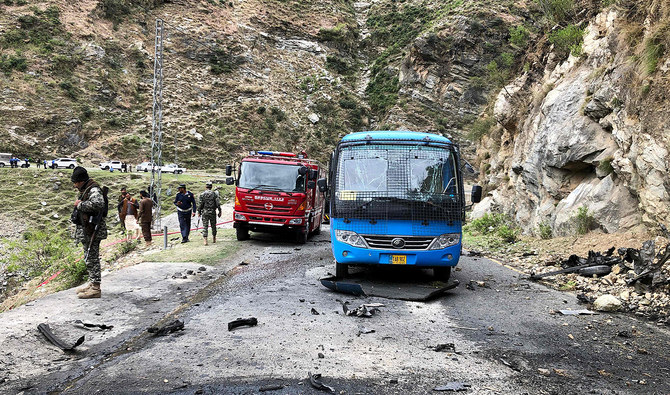
- Afghan defense ministry says the killings of Chinese nationals reflected the weakness of Pakistan’s security agencies
- Pakistan believes Kabul not doing enough to tackle militant groups, launched airstrikes targeting them in Afghanistan
KABUL: The Taliban defense ministry on Wednesday rejected Pakistan’s allegations that Afghans were involved in an attack on Chinese engineers, as ties between the neighboring nations sour amidst rising insecurity.
Pakistan’s military had said at a press conference on Tuesday that a suicide bomb attack in March in Pakistan’s northern Khyber Pakhtunkhwa province, that killed five Chinese engineers, was planned in neighboring Afghanistan, and that the bomber was an Afghan national.
“Afghans are not involved in such matters,” said Mufti Enayatullah Khorazmim, the spokesperson for Afghanistan’s Taliban-run Ministry of National Defense.
“Blaming Afghanistan for such incidents is a failed attempt to divert attention from the truth of the matter and we strongly reject it,” he added.
A suicide bomber rammed a vehicle into a convoy of Chinese engineers working on a dam project in northwest Pakistan in March, killing six people.
“The killing of Chinese citizens in an area of Khyber Pakhtunkhwa that is under tight security cover by the Pakistan Army shows the weakness of the Pakistani security agencies,” Khorazmim said.
Relations between Pakistan and Afghanistan have soured in recent months. Islamabad says Kabul is not doing enough to tackle militant groups targeting Pakistan and in March Pakistan carried out airstrikes targeting militants on Afghan territory.
Last year, Pakistan expelled nearly 370,000 undocumented Afghan nationals, saying the majority of suicide attacks against its security forces were carried out by Afghans, a charge Kabul rejected.
Pakistan’s military spokesman said on Tuesday that security for 29,000 Chinese nationals in Pakistan, many of them working on infrastructure projects, was the top priority for security institutions.
The Taliban are also seeking economic ties with China, the first country to formally appoint an ambassador to Kabul under the Taliban, and wish to join China-Pakistan Economic Corridor (CPEC), which is Beijing’s $65 billion investment in development and infrastructure.
Scientists link intense rainfall to climate change after floods in Pakistan, UAE
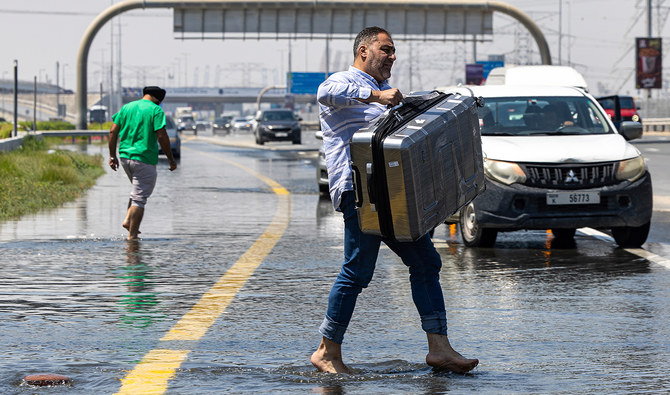
- Climate experts say warmer oceans lead to greater evaporation and warmer air can hold more water vapor
- Pakistan recorded double the amount of rainfall in April, while UAE received two years of rain in a single day
PARIS: Floods have been tearing a path of destruction across the globe, hammering Kenya, submerging Dubai, and forcing hundreds of thousands of people from Russia to China, Brazil and Somalia from their homes.
Though not all directly attributed to global warming, they are occurring in a year of record-breaking temperatures and underscore what scientists have long warned – that climate change drives more extreme weather.
Climate change isn’t just about rising temperatures but the knock-on effect of all that extra heat being trapped in the atmosphere and seas.
April was the 11th consecutive month to break its own heat record, the EU climate monitor Copernicus said on Wednesday, while ocean temperatures have been off the charts for even longer.
“The recent extreme precipitation events are consistent with what is expected in an increasingly warmer climate,” Sonia Seneviratne, an expert on the UN-mandated IPCC scientific panel, told AFP.
Warmer oceans mean greater evaporation, and warmer air can hold more water vapor.
Scientists even have a calculation for this: for every one degree Celsius in temperature rise, the atmosphere can hold seven percent more moisture.
“This results in more intense rainfall events,” Davide Faranda, an expert on extreme weather at the French National Center for Scientific Research (CNRS), told AFP.
In April, Pakistan recorded double the amount of normal monthly rainfall — one province saw 437 percent more than average — while the UAE received about two years’ worth of rain in a single day.
This, however, doesn’t mean everywhere on Earth is getting wetter.
Richard Allan from the University of Reading said “a warmer, thirstier atmosphere is more effective at sapping moisture from one region and feeding this excess water into storms elsewhere.”
This translates into extreme rain and floods in some areas but worse heatwaves and droughts in others, the climate scientist told AFP.
Natural climate variability also influences weather and global rainfall patterns.
This includes cyclical phenomenon like El Nino, which tends to bring heat and rain extremes, and helped fuel the high temperatures seen over land and sea this past year.
While natural variability plays a role “the observed long-term global increase in heavy precipitation has been driven by human-induced climate change,” said Seneviratne.
Carlo Buontempo, a director at Copernicus, said cycles like El Nino ebb and flow but the extra heat trapped by rising greenhouse gas emissions would “keep pushing the global temperature toward new records.”
Considering the overlapping forces at play, attributing any one flood to climate change alone can be fraught, and each event must be taken on a case-by-case basis.
But scientists have developed peer-reviewed methods that allow for the quick comparison of an event today against simulations that consider a world in which global warming had not occurred.
For example, World Weather Attribution, the scientists who pioneered this approach, said the drenching of the UAE and Oman last month was “most likely” exacerbated by global warming caused by burning fossil fuels.
ClimaMeter, another rapid assessment network who use a different methodology, said major floods in China in April were “likely influenced” by global warming and El Nino.
“It can be difficult to disentangle global warming and natural variability” and some weather events are more clear-cut than others, said Flavio Pons, a climatologist who worked on the China assessment.
In the case of devastating floods in Brazil, however, ClimaMeter were able to exclude El Nino as a significant factor and name human-driven climate change as the primary culprit.
Many of the countries swamped by heavy floods at the moment — such as Burundi, Afghanistan and Somalia — rank among the poorest and least able to mobilize a response to such disasters.
But the experience in Dubai showed even wealthy states were not prepared, said Seneviratne.
“We know that a warmer climate is conducive to more severe weather extremes but we cannot predict exactly when and where these extremes will occur,” Joel Hirschi from the UK’s National Oceanography Center told AFP.
“Current levels of preparedness for weather extremes are inadequate... Preparing and investing now is cheaper than delaying action.”










